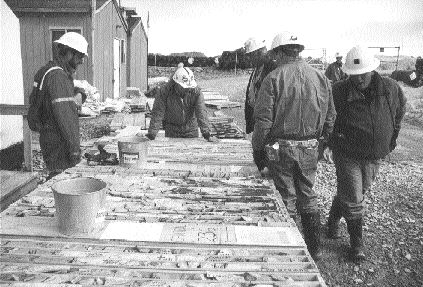A deep drilling campaign at the Boston gold deposit of
Two drill holes completed in late summer intersected the mineralization, one at about 1,000 metres below surface and the other nearly 1,400 metres deep.
The deeper of the two holes, S03-295W, cut anomalous gold values in sedimentary rocks rather than in the main volcanic sequence that hosts most of the Boston mineralization. The sediments showed alteration similar to that surrounding the shallower gold mineralization at Boston. Small-scale folding, visible in the core, suggests the hole just missed the hinge of the Boston fold, which marks the northern limit of the volcanic sequence.
The intersection was narrow, only 0.3 metre, but graded 7.3 grams gold per tonne. The gold appears to occur in structures crosscutting the stratigraphy and the fold hinge, which continue northward into the sediments, and the structure apparently correlates with the B2 zone, the westernmost of Boston’s three main zones.
Miramar geologists believe that having intersected gold mineralization in the deep hole demonstrates that the mineralizing system extends at least to 1,400 metres.
Hole S03-295W also intersected two gold zones east of the known mineralization. A broad zone of gold mineralization, over 78.9 metres of core length, graded 1.3 grams gold per tonne but included narrower high-grade zones — one of 1.6 metres grading 21.9 grams per tonne and another of 2 metres grading 9.9 grams. It is not clear whether the mineralization represents a new zone, and the holes may have been drilled sub-parallel to the mineralized structures.
The shallower hole, S03-293W2, was wedged from an earlier hole that tested Boston mineralization at depths of around 1,000 metres. The hole is thought to have intersected both the B3 and B2 zones. A 0.4-metre intersection down-plunge from B3 graded 10.9 grams gold per tonne and contained visible gold. Three intersections down-plunge from known B2 mineralization intersected 0.3 metre grading 15.8 grams, 5.2 metres grading 3.1 grams, and 10.1 metres grading 2.3 grams gold per tonne.
The intersections’ true widths were about 88% of core length at this depth.
Boston’s measured and indicated resource, calculated in late 2002 to a vertical depth of about 520 metres, runs to 1.4 million tonnes grading 15.4 grams gold per tonne. With inferred resources included, the resource grows to 4 million tonnes grading 12.5 grams gold per tonne.


Be the first to comment on "Boston deep drilling cuts gold"